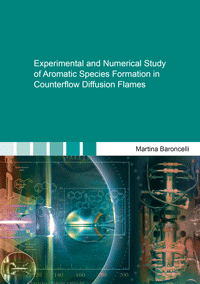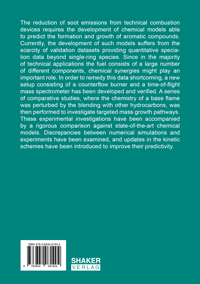
Shop : Details
Shop
Details
48,80 €ISBN 978-3-8440-8140-4Softcover198 pages82 figures293 g21 x 14,8 cmEnglishThesis
August 2021
Martina Baroncelli
Experimental and Numerical Study of Aromatic Species Formation in Counterflow Diffusion Flames
The reduction of soot emissions from technical combustion devices requires the development of chemical models able to predict the formation and growth of aromatic compounds. Currently, the development of such models suffers from the scarcity of validation datasets providing quantitative speciation data beyond single-ring species. Since in the majority of technical applications the fuel consists of a large number of different components, chemical synergies might play an important role. In order to remedy this data shortcoming, a new setup consisting of a counterflow burner and a time-of-flight mass spectrometer has been developed and verified. A series of comparative studies, where the chemistry of a base flame was perturbed by the blending with other hydrocarbons, was then performed to investigate targeted mass growth pathways. These experimental investigations have been accompanied by a rigorous comparison against state-of-the-art chemical models. Discrepancies between numerical simulations and experiments have been examined, and updates in the kinetic schemes have been introduced to improve their predictivity.
Keywords: soot; aromatics; pollution; combustion; pyrolysis; chemical models
Export of bibliographic data
Shaker Verlag GmbH
Am Langen Graben 15a
52353 Düren
Germany
Am Langen Graben 15a
52353 Düren
Germany
Mon. - Thurs. 8:00 a.m. to 4:00 p.m.
Fri. 8:00 a.m. to 3:00 p.m.
Fri. 8:00 a.m. to 3:00 p.m.
Contact us. We will be happy to help you.



